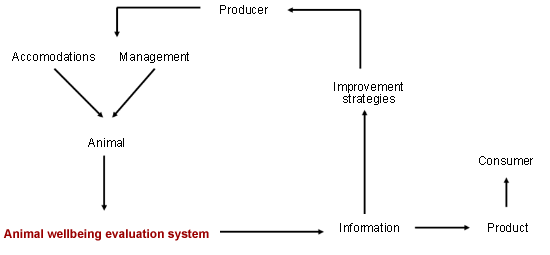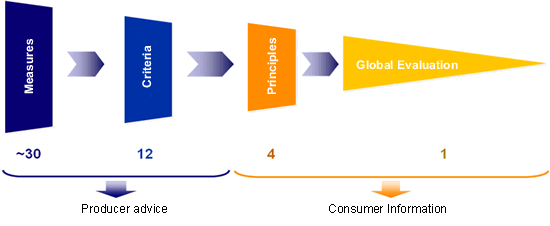
Figure 1. Scheme of the evaluation of animal welfare.
Animal wellbeing can be affected by many factors that compromise health, physical as well as mental. After being debated by consumers, scientists, business representatives and legislatures, Welfare Quality® defined 4 principles of animal wellbeing: good feed, good accommodations, good health, and appropriate behaviour. Within these principles, 12 different, but complimentary, criteria were identified (figure 2). For the porcine species, three distinct evaluation protocols were developed to measure each of the 12 criteria: sows and piglets on the farm, fattening pigs on the farm, and lastly fattening pigs in the slaughterhouse. They identified between 25 and 30 measures for each protocol, based on scientific bibliographies or on research studies carried out during the project. These measures were evaluated to insure their validity when reflecting the animals’ real wellbeing. Plus, each measure should be clear enough to permit a rapid and precise evaluation after a short period of training and with little variation among observers. The ease of the implementation of this in practical conditions is key to its use in actual production systems. Given that animals are kept in different environments, it is important that the measures be applicable to all systems. Keeping in mind that the majority of the measures developed by Welfare Quality® are based on the animal, an assessor could evaluate wellbeing by directly observing the animal, regardless of how and where it is kept. In order to complete these systems, Welfare Quality® has collaborated with an independent standardizing institute to create the first complete series of European protocols for the evaluation of the wellbeing of production animals (www.welfarequality.net).
| Principles | Criteria |
| Feed | Absence of exposure to prolonged hunger |
| Absence of exposure to prolonged thirst | |
| Accomodations | Abillity to rest comfortably |
| Thermal confort | |
| Ease of movement | |
| Sanitary status | Absence of lesions |
| Absence of illness | |
| Absence of pain due to handling | |
| Behavior | Adequate expression of social behavior |
| Adequate expression of other behaviors | |
| Positive human-animal relations | |
| Positive emotional state |
The results, which are obtained independently for each of the different measures are combined to calculate the final score obtained in each criterion. The measures that are found within a certain criteria will be considered based on the opinion of several scientific panels, combining them to get a final score between 0 and 100, where 0 means more wellbeing problems and 100 means the best situation for that specific criterion. This evaluation should serve to identify wellbeing problems and to advise the producer on improvement strategies in each one of the criteria.
On the other hand, the information that is transmitted to the consumer sums up the results of the 12 criteria in a general score, which reflects the wellbeing of the animals on a determined farm or slaughterhouse. For this, the first step is to obtain a score for each one of the principles by combining the scores obtained in the different criteria (figure 3). This relationship is asymmetric, and is taken into account because of the importance the scientific panels have given to each one of the criteria within a determined principle. For example, the principle of good feed, which is made up of the criteria stating the animals shall not be subjected to prolonged thirst or hunger. However, the experts consider that, from an animal wellbeing point of view, thirst is worse than hunger, and therefore with a good score in the area of “absence of exposure to prolonged hunger”, it is possible to obtain a bad score in the principle of “good feed” if the criteria of “absence of exposure to prolonged thirst” has been scored badly.

Figure 3. use of the animal wellbeing evaluation system.
Lastly, the final scoring on a farm will be determined by combining the 4 scores (from 0 to 100) obtained for each one of the principles evaluated (figure 3). In this case, a score of excellent, according to the experts, is considered to be a score of 80 and up, good is a score above 55 and acceptable is a score above 20. However, once more, the values have been devised so that in order to obtain a score of excellent, the four principles must have a minimum score of 55, and two of them must be above 80.




